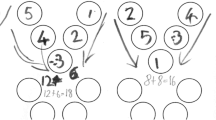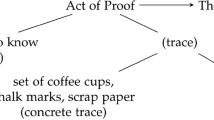Abstract
Counter-examples, which are a distinct kind of example, have a functional role in inducing logically deductive reasoning skills in the learning process. In this investigation, we compare the ability of students and prospective teachers in South Korea and Hong Kong to use counter-examples to justify mathematical propositions. The results highlight that South Korean students performed better than Hong Kong students at justifying propositions using counter-examples in algebra problems, but both did equally well in geometry problems. In terms of the prospective teachers’ ability to justify propositions using counter-examples in two particular topics, properties of the absolute value function and parallelogram, Hong Kong prospective teachers performed relatively weakly in the absolute value problem but better in the parallelogram problem compared with South Korean prospective teachers. The weaknesses and strengths of students and prospective teachers in generating counter-examples associated with logical reasoning in mathematical contexts in the two regions indicate ways of improving the effectiveness of learning and teaching mathematics through the use of counter-examples.







Similar content being viewed by others
References
Balacheff, N. (1991). Treatment of refutations: Aspects of the complexity of a constructivist approach to mathematics learning. In E. von Glasersfeld (Ed.), Radical constructivism in mathematics education (pp. 89–110). Dordrecht: Kluwer.
Bills, L., Dreyfus, T., Mason, J., Tsamir, P., Watson, A., & Zaslavsky, O. (2006). Exemplification in mathematics education. In Proceedings of the 30th conference of the international group for the psychology of mathematics education, Prague, Czech Republic, Vol. 1, pp. 126–154.
Boats, J. J., Dwyer, N. K., Laing, S., & Fratella, M. P. (2003). Geometric conjectures: The importance of counterexamples. Mathematics Teaching in the Middle School, 9(4), 210–215.
Corleis, A., Schwarz, B., Kaiser, G., & Leung, I. K. C. (2008). Content and pedagogical content knowledge in argumentation and proof of future teachers: a comparative case study in Germany and Hong Kong. ZDM—The International Journal on Mathematics Education, 40(5), 813–832.
Curriculum Development Council. (1999). Syllabuses for secondary schools—mathematics (secondary 1–5). Hong Kong: The Printing Department.
Curriculum Development Council. (2007). Mathematics education key learning area: Mathematics curriculum and assessment guide (secondary 4–6). Hong Kong: Government Logistics Department.
de Villiers, M. (1994). The role and function of a hierarchical classification of quadrilaterals. Learning of Mathematics, 14(1), 11–18.
Goldenberg, P., & Mason, J. (2008). Shedding light on and with example spaces. Educational Studies in Mathematics, 69(2), 183–194.
Gruenwald, N., & Klymchuk, S. (2002). Using counter-examples to enhance students’ conceptual understanding in engineering undergraduate mathematics: A parallel study. In Proceedings of international conference on teaching mathematics at the undergraduate level, Crete, Greece.
Hill, H. C., Ball, D. L., & Schilling, S. G. (2008). Unpacking pedagogical content knowledge: Conceptualizing and measuring teachers’ topic-specific knowledge of students. Journal for Research in Mathematics Education, 39(4), 372–400.
Ho, S. C., Chun, K. W, Yip, D. Y., Wong, K. M, Chiu, M. M., Sze, M. M. Lo, N. K., Chung, Y. P., Tsang, W. K., Man Y. F., & Ho, W. K. (2003). The first HKPISA report: monitoring the quality of education in Hong Kong from an international perspective. Hong Kong PISA Centre, Chinese University of Hong Kong.
Iannone, P., & Nardi, E. (2004). Counterexamples: Is one as good as many? In Proceedings of the 4th Mediterranean conference on mathematics education, pp. 379–388.
Kachapova, F., Black, M., Klymchuk, S., & Kachpov, L. (2007). Counter-examples and paradoxes in teaching mathematical statistics: A case study. Mathematics Teaching-Research Journal (Online), 2(1), 104–115.
Klymchuk, S. (2005). Counter-examples in teaching/learning of calculus: Students’ performance. New Zealand Mathematics Magazine, 42(1), 31–38.
Ko, Y. Y., & Knuth, E. (2009a) Problems manifested in prospective secondary mathematics teachers’ proofs and counterexamples in differentiation. In Proceedings of the ICMI study 19 conference: Proof and proving in mathematics education, Vol. 1, pp. 262–267.
Ko, Y. Y., & Knuth, E. (2009b). Undergraduate mathematics majors’ writing performance producing proofs and counterexamples in continuous functions. Journal of Mathematical Behavior, 28(1), 68–77.
Lakatos, I. (1976). Proofs and refutations: The logic of mathematical discovery. Cambridge: Cambridge University Press.
Leung, I. K. C. (2008). Teaching and learning of inclusive and transitive properties among quadrilaterals by deductive reasoning with the aid of Smart Board. ZDM—The International Journal on Mathematics Education, 40(6), 1007–1021.
Mason, J. (2011). Phenomenology of example construction. ZDM—The International Journal on Mathematics Education, 43(2), 195–204.
Mason, J., & Klymchuk, S. (2009). Using counter-examples in calculus. London: Imperial College Press.
Mayer, R. E. (2003). The promise of multimedia learning: Using the same instructional design methods across different media. Learning and Instruction, 13, 125–139.
Michener, E. (1978). Understanding mathematics. Cognitive Science, 2, 361–383.
Ministry of Education, Science and Technology (2011). The 2011 revised (Korean) national curriculum of mathematics (announced in August 2011. Official notification number 2011–351).
National Council of Teachers of Mathematics. (2000). Principles and standards for school mathematics. Reston, VA: The Author.
OECD (2007). PISA 2006: Science competencies for tomorrow’s world. Executive summary. http://www.pisa.oecd.org/dataoecd/15/13/39725224.pdf. Accessed 5 July 2012.
Peled, I., & Balachaff, N. (2011). Beyond realistic considerations: Modeling conceptions and controls in task examples with simple word problems. ZDM—The International Journal on Mathematics Education, 43(2), 307–315.
Peled, I., & Zaslavsky, O. (1997). Counter-examples that (only) prove and counter-examples that (also) explain. Focus on Learning Problems in Mathematics, 19(3), 49–61.
Potarri, D., Zachariades, T., & Zaslavaky, O. (2009). Mathematics teachers’ reasoning for refuting students’ invalid claims. In Proceedings of CERME, Lyon, France. Work Group 2, pp. 281–290.
Seufert, T. (2003). Supporting coherence formation in learning from multiple representations. Learning and Instruction, 13(2), 227–237.
Tapan, M. S. (2009). Preservice teachers’ use of spatio-visual elements and their level of justification dealing with a geometrical construction problem. US-China Education Review, 6(3), 54–60.
Watson, A., & Mason, J. (2002a). Extending example spaces as a learning/teaching strategy in mathematics. In A. Cockburn, & E. Nardi (Eds.), Proceedings of the 26th conference of the international group for the psychology of mathematics education, Vol. 4, pp. 377–385.
Watson, A., & Mason, J. (2002b). Student-generated examples in the learning of mathematics. Canadian Journal of Science, Mathematics and Technology Education, 2(2), 237–249.
Zaslavsky, O., & Ron, G. (1998). Students’ understanding of the role of counter-examples. In Proceedings of the 22nd conference of the international group for the psychology of mathematics education, Stellenbosch, South Africa, Vol. 1, pp. 225–232.
Zazkis, R., & Chernoff, E. J. (2008). What makes a counter-example exemplary? Educational Studies in Mathematics, 68, 195–208.
Zodik, I., & Zaslavsky, O. (2008). Characteristics of teachers’ choice of examples in and for the mathematics classroom. Educational Studies in Mathematics, 69(2), 165–182.
Acknowledgments
The research project is supported by the Special Project Grant funded by the Hong Kong Institute of Education: FAS/0508/MSST/09.
Author information
Authors and Affiliations
Corresponding author
Appendices
Appendix 1
1.1 Item questions for students
Determine whether the following statements are true or false. If the statement is true, then explain the reason. If the statement is false, then provide a counter-example and explain why it is a counter-example.

Appendix 2
2.1 Item questions for prospective teachers
Determine whether the following students’ answers are correct or incorrect. Put a “✓” or “×” to indicate your judgment of the students’ initial answer of ‘true’ or ‘false’. If you decide that the student’s answer is incorrect, explain the reason. Explain your teaching method to get students to give the correct answer.

Appendix 3
See Tables 5, 6, 7, 8, 9 and 10.
Rights and permissions
About this article
Cite this article
Leung, I.K.C., Lew, Hc. The ability of students and teachers to use counter-examples to justify mathematical propositions: a pilot study in South Korea and Hong Kong. ZDM Mathematics Education 45, 91–105 (2013). https://doi.org/10.1007/s11858-012-0450-x
Accepted:
Published:
Issue Date:
DOI: https://doi.org/10.1007/s11858-012-0450-x




